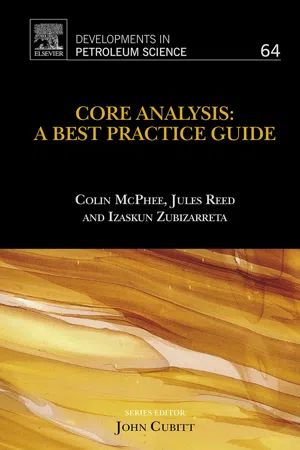
- 852 pages
- English
- ePUB (mobile friendly)
- Available on iOS & Android
About this book
Core Analysis: A Best Practice Guide is a practical guide to the design of core analysis programs. Written to address the need for an updated set of recommended practices covering special core analysis and geomechanics tests, the book also provides unique insights into data quality control diagnosis and data utilization in reservoir models.The book's best practices and procedures benefit petrophysicists, geoscientists, reservoir engineers, and production engineers, who will find useful information on core data in reservoir static and dynamic models. It provides a solid understanding of the core analysis procedures and methods used by commercial laboratories, the details of lab data reporting required to create quality control tests, and the diagnostic plots and protocols that can be used to identify suspect or erroneous data.- Provides a practical overview of core analysis, from coring at the well site to laboratory data acquisition and interpretation- Defines current best practice in core analysis preparation and test procedures, and the diagnostic tools used to quality control core data- Provides essential information on design of core analysis programs and to judge the quality and reliability of core analysis data ultimately used in reservoir evaluation- Of specific interest to those working in core analysis, porosity, relative permeability, and geomechanics
Frequently asked questions
- Essential is ideal for learners and professionals who enjoy exploring a wide range of subjects. Access the Essential Library with 800,000+ trusted titles and best-sellers across business, personal growth, and the humanities. Includes unlimited reading time and Standard Read Aloud voice.
- Complete: Perfect for advanced learners and researchers needing full, unrestricted access. Unlock 1.4M+ books across hundreds of subjects, including academic and specialized titles. The Complete Plan also includes advanced features like Premium Read Aloud and Research Assistant.
Please note we cannot support devices running on iOS 13 and Android 7 or earlier. Learn more about using the app.
Information
Best Practice in Coring and Core Analysis
Abstract
1.1 Core Analysis Data: The Foundation of Formation Evaluation

| Parameter | Data Source | Test Methods |
| Net | Permeability | Air permeability (ambient or reservoir stress) Klinkenberg permeability (ambient or reservoir stress) Brine (water) permeability (ambient or reservoir stress) Probe permeability (ambient conditions) |
| Porosity | Density porosity | Helium porosity (ambient or reservoir stress) Resaturation porosity (ambient or reservoir stress) |
| Water saturation | Electrical parameters | Formation resistivity factor (ambient or reservoir stress) Resistivity index (ambient or reservoir-appropriate conditions) Wet chemistry cation exchange capacity (CEC) for shaly sands (ambient conditions) Multiple-salinity tests (normalised CEC) at ambient or reservoir stress |
| Primary drainage capillary pressure | Low-pressure mercury injection (ambient or reservoir stress) High-pressure mercury injection (ambient conditions) Gas–water or oil–water porous plate (ambient or reservoir-appropriate conditions) Gas–water or oil–water centrifuge (ambient conditions or limited reservoir stress) | |
| Direct measurement | Retort extraction (ambient conditions) Dean-Stark extraction (ambient conditions) |

Table of contents
- Cover image
- Title page
- Table of Contents
- Copyright
- Series Editor's Preface
- Preface
- Chapter 1: Best Practice in Coring and Core Analysis
- Chapter 2: Wellsite Core Acquisition, Handling and Transportation
- Chapter 3: Core Laboratory Processing and Screening
- Chapter 4: Core Sample Preparation
- Chapter 5: Routine Core Analysis
- Chapter 6: Preparation for Special Core Analysis
- Chapter 7: Wettability and Wettability Tests
- Chapter 8: Electrical Property Tests
- Chapter 9: Capillary Pressure
- Chapter 10: Relative Permeability
- Chapter 11: Nuclear Magnetic Resonance (NMR)
- Chapter 12: Geomechanics Tests
- Chapter 13: Example of a Core Analysis Programme
- Index
